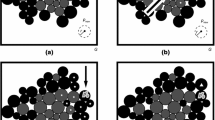Abstract
Simulation of granular particles is an important tool in many fields. However, simulation of particles of complex shapes remains largely out of reach even in two-dimension. One of the major hurdles is the difficulty in representing particles in an efficient, flexible, and accurate manner. By representing particles as convex polyhedrons which are themselves the intersection of a set of half spaces, we develop a method that allows one to efficiently carry out key operations, including particle–particle and particle–container wall overlapping detection, precise identification of the overlapping region, particle shifting, particle rotation, and others. The simulation of packing 1,000 particles into a container takes only a few minutes with this approach. We further demonstrate the potential of this approach with a simulation that re-generates the “Brazil nut” phenomenon by mixing and shaking particles of two different sizes.
Similar content being viewed by others
References
Remond S., Gallias J.L., Mizrahi A.: Simulation of the packing of granular mixtures of non-convex particles and voids characterization. Granul. Matter 10(3), 157–170 (2008). doi:10.1007/s10035-007-0082-y
Al-Raoush R., Alsaleh M.: Simulation of random packing of polydisperse particles. Powder Technol. 176(1), 47–55 (2007). doi:10.1016/j.powtec.2007.02.007
Yu A.B., An X.Z., Zou R.P., Yang R.Y., Kendall K.: Self-assembly of particles for densest packing by mechanical vibration. Phys. Rev. Lett. 97(26), 265501 (2006). doi:10.1103/PhysRevLett.97.265501
Fraige F.Y., Langston P.A., Chen G.Z.: Distinct element modelling of cubic particle packing and flow. Powder Technol. 186(3), 224–240 (2008). doi:10.1016/j.powtec.2007.12.009
Abreu C.R.A., Tavares F.W., Castier M.: Influence of particle shape on the packing and on the segregation of spherocylinders via Monte Carlo simulations. Powder Technol. 134(1–2), 167–180 (2003). doi:10.1016/S0032-5910(03)00151-7
Song Y., Turton R., Kayihan F.: Contact detection algorithms for DEM simulations of tablet-shaped particles. Powder Technol. 161(1), 32–40 (2006). doi:10.1016/j.powtec.2005.07.004
Jia X., Williams R.A.: A packing algorithm for particles of arbitrary shapes. Powder Technol. 120(3), 175–186 (2001). doi:10.1016/S0032-5910(01)00268-6
Lu M., McDowell G.: The importance of modelling ballast particle shape in the discrete element method. Granul. Matter 9(1), 69–80 (2007). doi:10.1007/s10035-006-0021-3
Lim W.L., McDowell G.R.: Discrete element modelling of railway ballast. Granul. Matter 7(1), 19–29 (2005). doi:10.1007/s10035-004-0189-3
Wang L., Park J.-Y., Fu Y.: Representation of real particles for DEM simulation using X-ray tomography. Construct. Build. Mater. 21(2), 338–346 (2007). doi:10.1016/j.conbuildmat.2005.08.013
Lee Y., Yang C.T., Chien C.S.: A 3D ellipsoid-based model for packing of granular particles. Int. J. Comput. Appl. Technol. 17(3), 148–155 (2003). doi:10.1504/IJCAT.2003.000342
Remond S., Gallias J.L.: A 3D semi-digital model for the placing of granular materials. Powder Technol. 148(1), 56–59 (2004). doi:10.1016/j.powtec.2004.09.026
Matuttis H.G., Luding S., Herrmann H.J.: Discrete element simulations of dense packings and heaps made of spherical and non-spherical particles. Powder Technol. 109(1–3), 278–292 (2000). doi:10.1016/S0032-5910(99)00243-0
De Pellegrin D.V., Stachowiak G.W.: Simulation of three-dimensional abrasive particles. Wear 258(1–4), 208–216 (2005). doi:10.1016/j.wear.2004.09.040
Bezrukov A., Bargiel M., Stoyan D.: Statistical Analysis of Simulated Random Packings of Spheres. Particle Particle Syst. Characterization. 19(2), 111–118 (2002). doi:10.1002/1521-4117(200205)19:2<111::AID-PPSC111>3.0.CO;2-M
Dantzig G.B.: Linear Programming and Extensions. Princeton University Press, Princeton (1963)
Cormen T.H., Leiserson C.E., Rivest R.L.: Introduction to Algorithms. MIT Press, Cambridge (2001)
Nezami E.G., Hashash Y.M.A., Zhao D., Ghaboussi J.: A fast contact detection algorithm for 3-D discrete element method. Comput. Geotechnics. 31(7), 575–587 (2004). doi:10.1016/j.compgeo.2004.08.002
Rosato A., Strandburg K.J., Prinz F., Swendsen R.H.: Why the Brazil nuts are on top: Size segregation of particulate matter by shaking. Phys. Rev. Lett. 58(10), 1038 (1987). doi:10.1103/PhysRevLett.58.1038
Cleary P.W., Sawley M.L.: DEM modelling of industrial granular flows: 3D case studies and the effect of particle shape on hopper discharge. Appl. Math. Model. 26(2), 89–111 (2002). doi:10.1016/S0307-904X(01)00050-6
Castier M., Delgado Cuellar O., Tavares F.W.: Monte Carlo simulation of particle segregation. Powder Technol. 97(3), 200–207 (1998). doi:10.1016/S0032-5910(98)00009-6
Author information
Authors and Affiliations
Corresponding author
Rights and permissions
About this article
Cite this article
Lee, Y., Fang, C., Tsou, YR. et al. A packing algorithm for three-dimensional convex particles. Granular Matter 11, 307–315 (2009). https://doi.org/10.1007/s10035-009-0133-7
Received:
Published:
Issue Date:
DOI: https://doi.org/10.1007/s10035-009-0133-7




